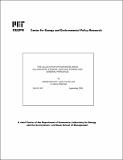| dc.contributor.author | Buchner, Barbara | en_US |
| dc.contributor.author | Carraro, Carlo | en_US |
| dc.contributor.author | Ellerman, A. Denny | en_US |
| dc.contributor.other | Massachusetts Institute of Technology. Center for Energy and Environmental Policy Research. | en_US |
| dc.date.accessioned | 2009-04-03T17:07:31Z | |
| dc.date.available | 2009-04-03T17:07:31Z | |
| dc.date.issued | 2006 | en_US |
| dc.identifier | 2006-015 | en_US |
| dc.identifier.uri | http://hdl.handle.net/1721.1/45061 | |
| dc.description.abstract | On January 1st, 2005, the EU Emissions Trading Scheme (EU ETS) scheme was officially launched, only two years after the European Council adopted the EU Emissions Trading Directive (European Community 2003). As a consequence of this formal start, the world's largest ever market in emissions has been established, and European companies now face a carbon-constrained reality in form of legally binding emission targets. Within essentially one year, 2004, the international carbon market has gained momentum through major policy developments and quick market responses, which among others have enabled the establishment of a framework for the EU carbon market. | en_US |
| dc.format.extent | 29 p | en_US |
| dc.publisher | MIT Center for Energy and Environmental Policy Research | en_US |
| dc.relation.ispartofseries | MIT-CEEPR (Series) ; 06-015WP. | en_US |
| dc.title | The allocation of European Union allowances : lessons, unifying themes and general principles | en_US |
| dc.type | Working Paper | en_US |
| dc.identifier.oclc | 159936014 | en_US |
